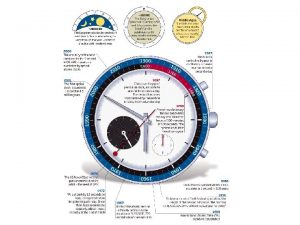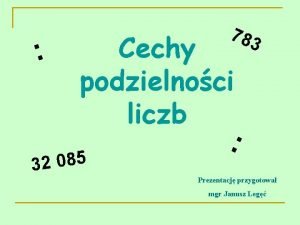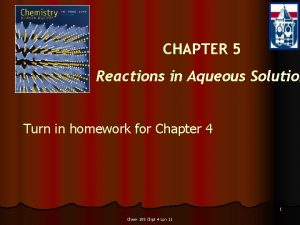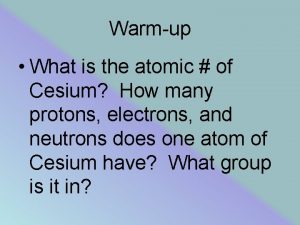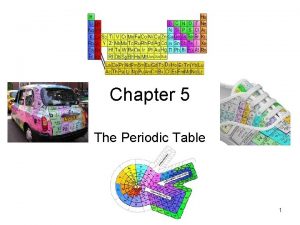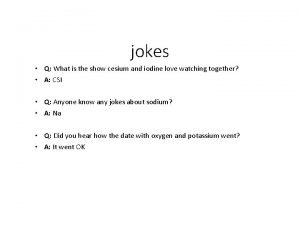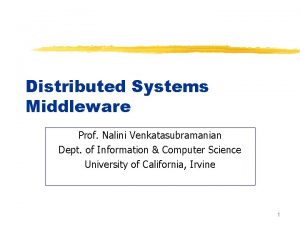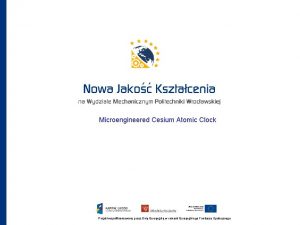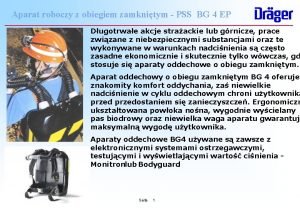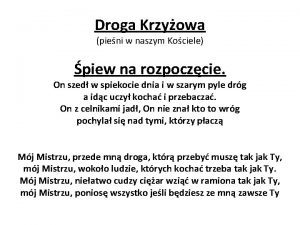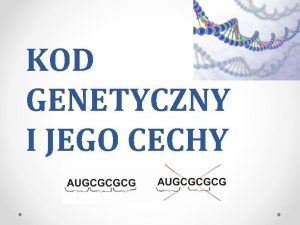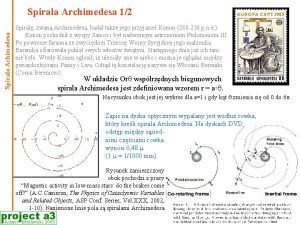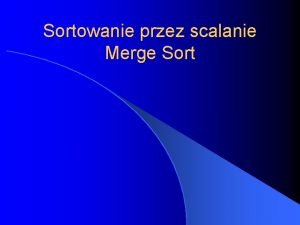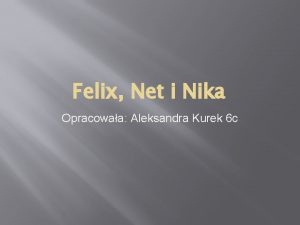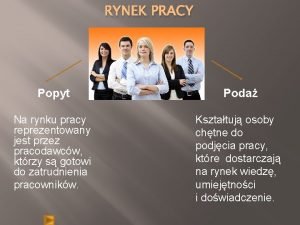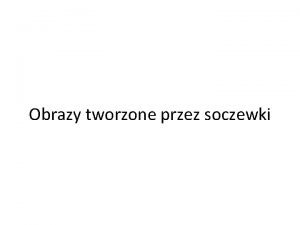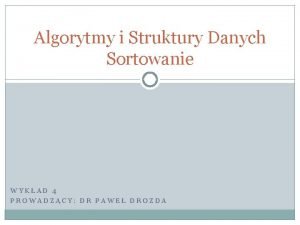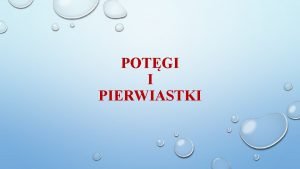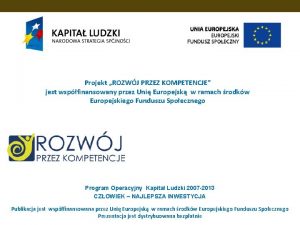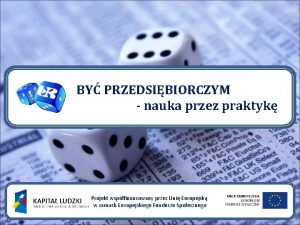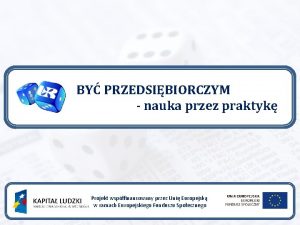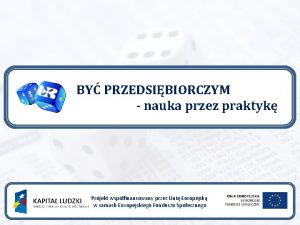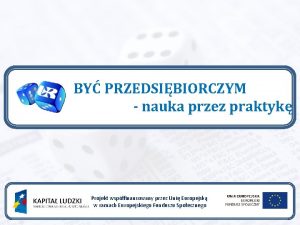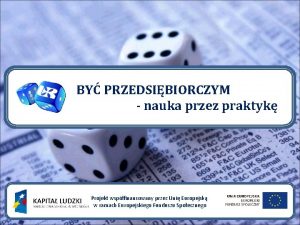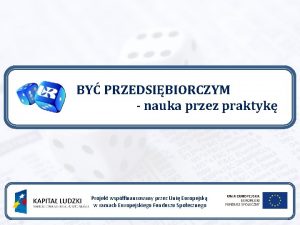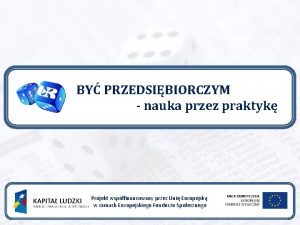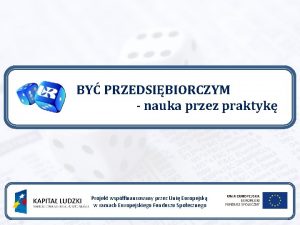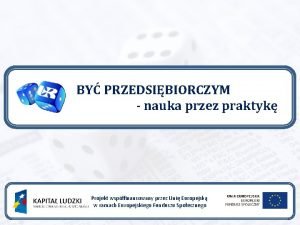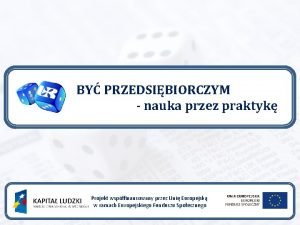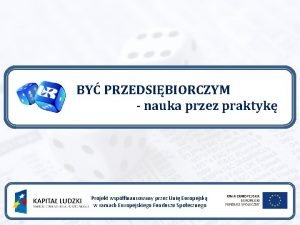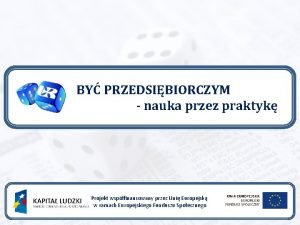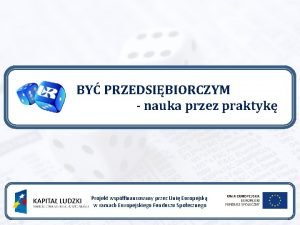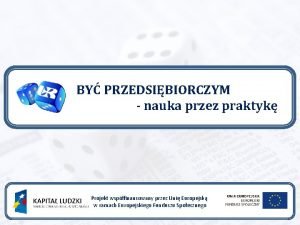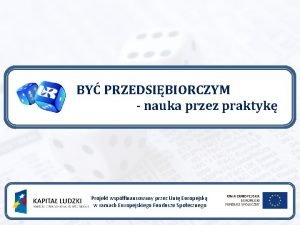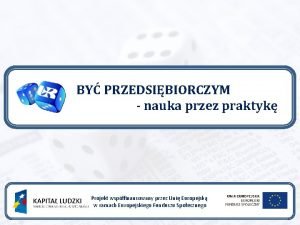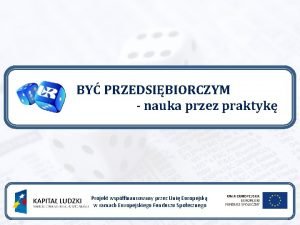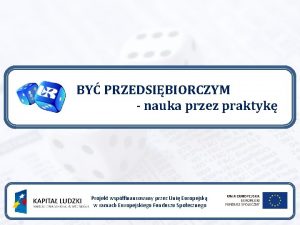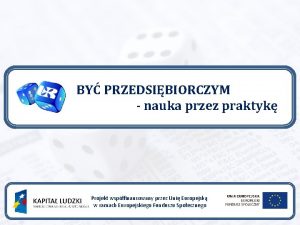Microengineered Cesium Atomic Clock Projekt wspfinansowany przez Uni


![Performance, Power and Size Stability of: Volume & Power of: Timing Error [ms/d] Power Performance, Power and Size Stability of: Volume & Power of: Timing Error [ms/d] Power](https://slidetodoc.com/presentation_image_h2/1afef5e0263e4a61553fd29bcf1ea710/image-3.jpg)




























- Slides: 31

Microengineered Cesium Atomic Clock Projekt współfinansowany przez Unię Europejską w ramach Europejskiego Funduszu Społecznego

CSAC – cesium atomic microclock Need of small, mass produced, very accurate (1 sec/ 1 000 years or better) clocks for: GPS, cellular phones, reference clocks in PC, internet, radars, etc. , Todays market: 3000 EUR for special applications and market niche 10 000 pcs/year Future market (2015): if price below 50 EUR niche is 10 000 pcs/year in 2015, YAGR is 20%, saturation of market niche in 2025. Total global niche: 0. 5 – 1 billion EUR/year (0. 7 billion USD) Key component: packaged MEMS Cs cell and micro optics.
![Performance Power and Size Stability of Volume Power of Timing Error msd Power Performance, Power and Size Stability of: Volume & Power of: Timing Error [ms/d] Power](https://slidetodoc.com/presentation_image_h2/1afef5e0263e4a61553fd29bcf1ea710/image-3.jpg)
Performance, Power and Size Stability of: Volume & Power of: Timing Error [ms/d] Power [W] 100000 0. 01 Volume [cm 3] 1000 0. 1 1 10 10 1000 Micro Atomic Clock 0. 01 0. 001 100000

Micro Atomic Clock; fields of applications • Navigation: – Unmanned Aerial Vehicle (UAV) SWARM; – Autonomous Ground Vehicles Navigation; – Better portable GPS receivers (longer Time to Subsequent fix (TTSF), 3 satellites instead of 4 – work in an urban area, …); – … • Security / encryption; – Dismounted IED jammers; – Hack-proof encryption algorithms; – … • Telecommunications network synchronization: – • Sensors: – – • Atomic Reference inside every cell phone = better timing = increase of the wireless link bandwidth / more simultaneous connections; Underwater sensors for seismic researches (oil / gas exploration); Magnetometers (remote NMR); Gyroscopes (drift < 0. 01°/hr); … Unpredicted / novel applications;

CSAC - is it realistic ? Atomic Cs clock of the future inside a wrist clock ? Atomic Cs/Rb clock today; a portable version, 7 kg weight Product of Temex, Swiss

The miniaturization MEMS fabrication CPT Example given for Cs |3 62 P 1/2 894 nm l 1 l 2 F=4 |2 nhf 62 S 1/2 F=3 |1

Coherent Population Trapping (CPT) – the basic phenomenon „for micro clocks” 62 P 1/2 |3 FWHM 1 k. Hz C 3% l 1 894 nm l 2 F=4 |2 nhf 62 S 1/2 F=3 |l 2 – l 1| = nhf |1

CSAC – sketch of the construction Microoptics VCSEL 852. 11 nm 4. 6 GHz Detector pin Narrowed line: better accuracy MEMS Cs cell 10 MHz F modulation VXCO VCO +N Cesium fully optic micro atomic clock with CPT effect. No microwave resonator. VCSEL laser light is FM modulated from local UHF oscillator. No external magnetic field applied.

A block schema of CPT-based micro atomic clock with an internal laser modulation MEOMS |3 62 P 1/2 894 nm ASIC 4. 6 GHz 70 nm F=4 l 1 l 2 |2 9 192 n 631 770 Hz hv 62 S 1/2 F=3 |1

DARPA’s CSAC project DARPA’s goal: • 200 X smaller (<1 cm 3), 300 X less power (<30 m. W) • short-term stability: sy(t) = 6 10 -10 t-1/2 • 11 participants: – NIST; – Symmetricom Inc. ; – Honeywell Labs; – Sarnoff Corporation; – Rockwell Scientific Company; – Teledyne; – Sandia; – … • over 300 million $ already spent to the project - at the moment the largest amount of many spent in MEMS/microelectronic area of invention

Review of solutions: first microclock of NIST CSAC

First CSAC – NIST USA 2004/2005. DARPA project, lasting 3 years, 12 mln USD pumped in NIST, Production not obtained. Main problem: degradation of cesium vapour; degassing from inner walls of silicon/glass micro-cell anodically bonded in nonoptimal low temperature

NIST CSAC Prototype, not applicable to the mass production • Advantages: – Reported very good short-term stability sy(t) = 6 10 -11 t-1/2; • Disadvantages: – Reported problems with a long-term stability of the inner buffer gas atmosphere; – Design and filling method not applicable to the mass production;

Teledyne CSAC

Teledyne CSAC Prototype, preproduction • Advantages: – Reported good short-term stability sy(t) = 1 10 -10 t-1/2; – Good quality of the optical field; – Good thermal design of the physics package; – Small volume <1 cm 3; – Low power 15 m. W; • Disadvantages: – Low-temperature bonding – In the current development state, not applicable to the mass production;

SANDIA / Symmetricom CSAC

SANDIA / Symmetricom CSAC Commercially available • Advantages: – Compact design; – Good thermal design of the physics package; – Applicable to the mass production; • Disadvantages: – Reported average short-term stability sy(t) = 3 10 -10 t-1/2; – 115 m. W; – 16 cm 3;

After several improvements: first product in 2011 (limited commercial acces)

European microclock consortium MAC-TFC 2008 -2012 PR 7,

New method of optical cesium MEMS cell fabrication by Dziuban, Gorecki, Mauri and collaborators Si Wet/DRIE anodic bonding glass Insert Cs dispenser Vacuum anodic bonding, annealing, pre-activation Cs IR laser Laser heating Cs dispensing

Cesium dispenser by SAES Italy, Materials: Cs 2 Mo. O 4 (cesium molybdate), Cs 2 Zr. O 3 (cesium zirconate), … St 101® (zirconium – aluminum alloy) or St 198® (zirconium – ferrum alloy)

Microcell fabrication Step 1: 1000 mm silicon substrate Step 3: 1 st bonding; 450°C, 1000 V Step 2: Deep reactive-ion etching + KOH etching Step 4: Cesium dispenser loading

Microcell fabrication Step 6: Cesium dispenser activation Step 5: 2 nd bonding 450°C, 1000 V Ne, Ar or mixture buffer gas Step 7: Cell use

www. memslab. pl The second in the World set-up for laser dispenser activation (WEMi. F M 6/37) - precisely controlled laser diode output power and laser diode temperature - precisely set exposition time (from 1 s to 999 s) - all setting and additional communicates visible on display

Set-up, dispensing and example of CPT laser Before and after activation (cesium inside) CPT as measured European best poster award of Eurosensors 2010 Linz For teams of WEMi. F, UFC FEMTO ST, SAES Getter, Uni. Ne

Just to show the scalling: study on cells microenginee ring made at for MAC-TFC PR 7 project CPT light

MEMS glass-Si-glass cell Cell before (up) and after (down) laser dispensing. Note golden drops of liquid cesium inside vacuum sealed ptical cell of atomic clock

First issue of the physic package Mark III of the microclock; launched on December 2011 Low-noise pin The cesium cel with Ne buffer gas VCSEL 894 nm microoptic

European cesium microclock 2012

The EC’s microclock 2012 A picture shows starting circuit (left) and the clock (right) together with real CPT curve. Accuracy: 1µs per year

This lecture showed spectacular European succes development of cesium microengineered microclock able to „fight” with USA’s development. This is extremely good example of profitable international collabaration of industrial and academic partners, including of WEMi. F of our Polytechnical University. It is pity, that transfer of the know-how will be done in Swiss and France. Not in our Country. Projekt współfinansowany przez Unię Europejską w ramach Europejskiego Funduszu Społecznego
 Cesium fountain atomic clock
Cesium fountain atomic clock Cecha podzielnosci przez 25
Cecha podzielnosci przez 25 Iron(iii) chloride (aq) + cesium phosphate (aq)
Iron(iii) chloride (aq) + cesium phosphate (aq) How many protons does cesium have
How many protons does cesium have Horizontal
Horizontal Predict whether cesium forms cs or cs2 ions
Predict whether cesium forms cs or cs2 ions Cesium telluride formula
Cesium telluride formula Cesium java
Cesium java Fast clock to slow clock synchronization
Fast clock to slow clock synchronization 1 minute = seconds
1 minute = seconds Atomic clock
Atomic clock Meoms
Meoms Atomic number vs atomic radius
Atomic number vs atomic radius Relative formula mass of hcl
Relative formula mass of hcl Atomic weight of oxygen
Atomic weight of oxygen Atomic trends
Atomic trends Atomic
Atomic Radius of lithium
Radius of lithium Mechanizm rozdwajania ja
Mechanizm rozdwajania ja Kontrola bg4
Kontrola bg4 On szedl w spiekocie dnia i w szarym pyle drog
On szedl w spiekocie dnia i w szarym pyle drog Kod genetyczny bezprzecinkowy
Kod genetyczny bezprzecinkowy Zdefiniowany przez archimedesa
Zdefiniowany przez archimedesa Unerwienie liścia tworzą
Unerwienie liścia tworzą Przyjaźń przez internet
Przyjaźń przez internet Sortowanie przez scalanie
Sortowanie przez scalanie Tata felixa odwiózł tam skarb znaleziony przez dzieci
Tata felixa odwiózł tam skarb znaleziony przez dzieci Przez kogo na rynku reprezentowany jest popyt
Przez kogo na rynku reprezentowany jest popyt Rodzaje soczewek
Rodzaje soczewek Najprostszy węglowodór nienasycony acetylen
Najprostszy węglowodór nienasycony acetylen Sortowanie bąbelkowe przykład
Sortowanie bąbelkowe przykład Pierwiastkowanie potęg
Pierwiastkowanie potęg
